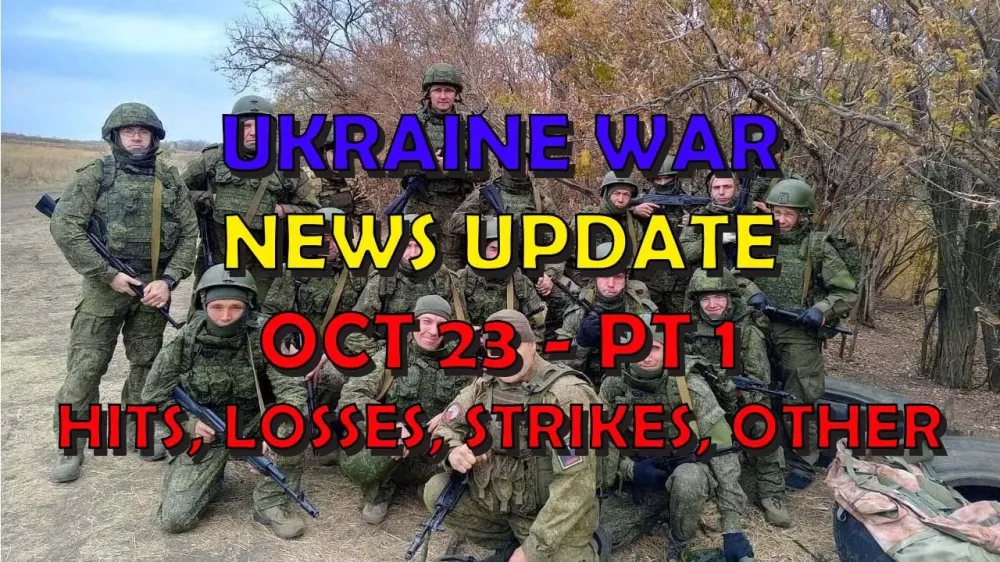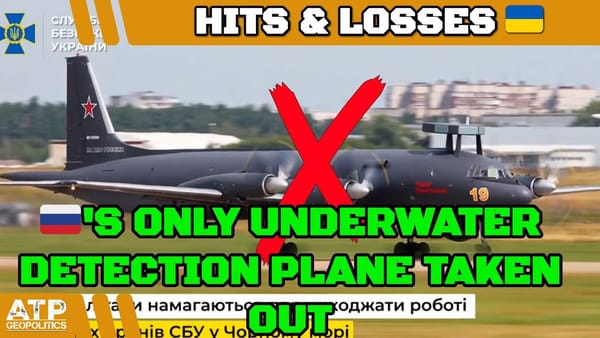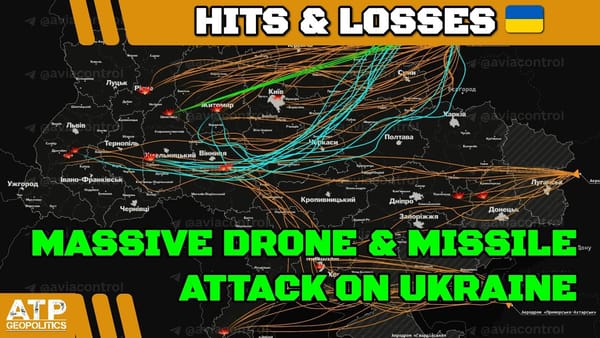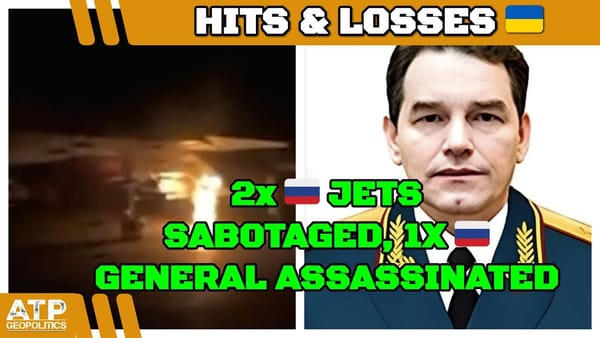Ukraine War Update NEWS: Pt 1 - Overnight & Other News
Table of Contents 📖
"They want this to be to expedite forced negotiations for Zelensky. Oh my goodness, you can't succeed because you've got the North Koreans in the zone."
Hello Team
🎦 00:00-01:15⏩
Jonathan starts the update with a warm welcome, acknowledging he's running a bit late due to his multiple sclerosis. He expresses gratitude to Mark and Jenny from the Little Whiskey Shop for their ongoing support of Ukraine, mentioning they gifted him a book titled "In 20 Stories: Ukrainian Tales of Hope, Humanity and Humour" by Anna Shevchenko.
Return to top⤴️
🪦 DISCLAIMER FOR GENERAL STAFF LOSSES DATA
- These are real people with real lives and real families who love them. Don’t let the numbers sap your humanity.
- These numbers probably aren’t accurate but they’re the best we have and we don’t need them to be accurate to be indicative of patterns of activity.
- All losses are estimates. Losses cannot be counted with accuracy because of the conditions on the ground.
- Both sides would see it to be of their advantage to minimize their own losses maximize the other side’s losses.
- Neither side releases their losses but we have enough transparency from the Ukrainian side to have confidence in they are indicative.
- Personnel losses are hard to count. If a soldier gets injured, heals up, and returns to the front line only to get injured again, is that one loss or two? Also, how to deal with losses from PMC’s or soldiers fighting with RF from occupied territories?
- Equipment losses are hard to count. If an AA complex involves several parts and one part gets disabled, is that a loss, or a fraction of a loss? If a tank gets disabled, repaired, back into the fight, then disabled again, is that one lost tank or two?
- All recorded losses are vulnerable to multiple reporting. We have already seen numerous cases of multiple drones in the air reporting the same loss from different angles as multiple engagements.
- Losses are not always reported on the same day they occurred. It is frequent that drone losses are reported at least 24 hours after other terrestrial equipment losses. Certain losses may not be reported for days or weeks for military intelligence reasons.
Ukrainian General Staff Report: High Russian Losses
🎦 01:15-03:51⏩
Jonathan reviews the Ukrainian General Staff's report on Russian losses, noting:
- Personnel losses are particularly high at 1,460, reflecting a trend of significant losses throughout the past month.
- Vehicles and fuel tank losses are also substantial at 106, nearing the record high.
- Other notable losses include nine tanks (close to the daily average), 30 armoured vehicles (above average), and 51 artillery systems (almost three times the average).
Jonathan infers from these figures that the Russians are relentlessly attacking, desperate to gain territory. He questions the sustainability of these attacks, speculating that Russia wouldn't be seeking troops from countries like North Korea if they had sufficient manpower. He advises caution regarding the provenance of such claims, emphasising the need for skepticism.
Return to top⤴️
Russian POWs Used as "Penal Soldiers" - Analysis
🎦 03:51-06:50⏩
Jonathan discusses a report from Yuri Butasov, a Ukrainian war correspondent, claiming that Russia is sending exchanged prisoners of war back to the front lines as punishment. According to the report, a group of Russian assault troops, all previously captured by the 110th Mechanised Brigade, were sent on a suicidal attack in the Pokrovsk direction after being returned to Russia. None survived. Jonathan, while acknowledging the need for confirmation, finds Butasov to be a generally reliable source. He uses this incident to support his hypothesis that Russia is facing significant troop shortages and is resorting to desperate measures. He questions how long Russia can sustain this approach.
Return to top⤴️
Concerns over North Korean Troop Deployment
🎦 06:50-09:40⏩
Jonathan expresses deep concern about the deployment of North Korean troops, fearing they will exacerbate the strain on already exhausted Ukrainian forces. He argues that even if the initial wave of 10,000 troops is quickly depleted, North Korea, facing its own food shortages, may be willing to provide a near-endless supply of soldiers in exchange for aid or technology. He cites reports suggesting the first North Korean troops are expected to arrive in Russia's Kursk Oblast today, with 2,600 expected by the end of October. He also highlights a video showing North Korean military personnel at a Russian training facility in Primorsky Krai.
Return to top⤴️
International Response to North Korean Involvement
🎦 09:40-11:30⏩
Jonathan discusses the muted international response to North Korea's involvement, suggesting it's a deliberate tactic by Russia and North Korea to stoke fear and pressure Ukraine into negotiations. He argues that their goal is to force Zelensky into a compromised position by creating the perception that Ukraine cannot win against a combined Russian-North Korean force. Jonathan, while acknowledging the seriousness of the situation, expresses confidence that Western powers are working behind the scenes to address the threat with appropriate sanctions and ramifications. He emphasises the need for a strong and measured response to deter further escalation.
Return to top⤴️
Evidence of Russian Troop Shortages
🎦 11:30-13:46⏩
Jonathan points to the discovery of identification documents belonging to foreign mercenaries, including soldiers from Sri Lanka, in the Kursk region as further evidence of Russia's desperation. He argues that the presence of foreign fighters in Kursk, Russian territory, indicates a severe shortage of Russian troops, as one would expect Russia to deploy its best soldiers to defend its homeland. He reiterates his belief that Russia is operating on a knife-edge, close to crumbling, yet still managing to hold on by throwing more resources, including foreign mercenaries, into the conflict.
Return to top⤴️
Russian Casualties in Kursk: Platoon Wiped Out
🎦 13:46-14:13⏩
Jonathan shares a report about an entire platoon from the 155th Separate Marine Brigade, the same unit heavily engaged in the Vuhledar area, being wiped out in Kursk. According to the report, all members of the platoon's 3rd Battalion, 4th Company, 3rd Platoon died near Sudzha on October 16th.
Return to top⤴️
Drone Warfare Update: Advancements and Challenges
🎦 14:13-18:06⏩
Jonathan discusses the evolving nature of drone warfare, highlighting key points from a conversation between Shashank Joshi (The Economist) and Andrei Liskovich (Ukraine Defence Fund). Advancements:
- First-person view (FPV) drones are now in their third generation, featuring larger airframes, increased payload capacity, frequency shifting capabilities for electronic warfare resistance, and more powerful signals.
- Ranges have increased to 20 kilometers with the potential for 40 kilometers using repeaters.
- Larger "bomber" drones are being deployed, capable of carrying 70-100 pounds of explosives over 20-35 miles. Their primary role is disrupting Russian supply lines by dropping mines.
- There's been exponential growth in the development and deployment of electronic warfare technology, with faster iteration cycles and wider frequency ranges.
Challenges:
- The proliferation of electronic warfare has led to instances of friendly fire.
- Passive electronic sensors used at the beginning of the war have been degraded by electronic warfare, forcing a shift to lower frequencies.
Jonathan expresses some uncertainty about the technical details of electronic warfare, inviting viewers with more expertise to share their insights.
Return to top⤴️
Ukraine Using French HAMMER Guided Glide Bombs
🎦 18:06-19:33⏩
Jonathan highlights footage of a building in Kursk being severely damaged in a Ukrainian strike, likely using a French HAMMER guided glide bomb. He notes that while the outer shell of the building remains standing, the structure is effectively destroyed. This incident underscores the growing sophistication of Ukraine's arsenal. He mentions that France will soon provide Ukraine with Mirage 2000-5F fighter jets, which are being upgraded to carry SCALP EG cruise missiles, HAMMER bombs, and MICA air-to-air missiles, further bolstering Ukraine's capabilities.
Return to top⤴️
Update on Russian Drone Attacks and Ukrainian Air Defence
🎦 19:33-21:43⏩
Jonathan provides an update on Russian drone attacks, noting that 81 drones were launched, with 57 shot down and 15 neutralized by electronic warfare. This represents a lower interception rate than usual, with nine drones (over 10%) reaching their targets. Jonathan expresses concern about this trend, even though the absolute number of successful attacks remains relatively low. He emphasises that even intercepted drones can cause damage when they fall to the ground.
Return to top⤴️
Zelensky Proposes Mutual Cessation of Energy Infrastructure Attacks
🎦 21:43-23:53⏩
Jonathan discusses Zelensky's proposal for a mutual cessation of attacks on energy infrastructure as a first step towards ending the "hot phase" of the war. He notes that this statement follows a recent Ukrainian strike on a Russian combined heat and power plant, a departure from Ukraine's usual focus on hydrocarbon infrastructure and military targets. Jonathan speculates that Zelensky's proposal might reflect Ukraine's increasing vulnerability to Russian attacks on its energy grid. By agreeing to a mutual cessation, Ukraine could buy time to repair and strengthen its infrastructure while potentially easing the pressure on its energy supplies. He acknowledges that this is just speculation and the situation remains fluid.
Return to top⤴️
Zelensky Dismisses Rumours of Defence Official Replacements
🎦 23:53-24:33⏩
Jonathan reports that Zelensky has dismissed rumours about replacing key defence officials, confirming that there are no plans to remove Chief of Defence Intelligence Kyrylo Budanov or Defence Minister Rustem Umerov. He notes that while he had heard rumours about Budanov's potential removal, Zelensky's statement suggests, at least for now, that both officials retain his confidence.
Return to top⤴️
Battle for Seladovye: Ukrainians Encircled
🎦 24:33-25:46⏩
Jonathan shifts focus to the battlefield, reporting that the battle for Seladovye, on the southern area of the Prokrosk front, continues to rage. Ukrainian forces are facing encirclement, with Russian troops having surrounded the city from the south after intense artillery bombardments and assaults. While there's still a narrow escape route to the northwest, the situation appears dire for the defending Ukrainians.
Return to top⤴️
Russian Offensive in Kursk: Gains and Potential for Zaporizhia Push
🎦 25:46-27:52⏩
Jonathan discusses Russia's offensive in Kursk, noting that they have retaken approximately half of the territory captured by Ukraine in August 2024. He acknowledges that Russia's gains are not unexpected given its military might, and questions whether Ukraine's incursion into Kursk was always intended as a temporary measure to draw Russian troops away from other fronts. Jonathan also addresses rumours of a potential Russian push south towards Zaporizhia. He expresses skepticism, given that Russia appears to be struggling to maintain its offensive in Kursk. He questions why Russia would deploy foreign mercenaries in Kursk if it had reserves available for an offensive elsewhere. However, he acknowledges the possibility that Russia might be prioritizing a southern offensive and is using mercenaries in Kursk as a stopgap measure.
Return to top⤴️
Tataragami's Analysis: Approaching the End of the Active War Phase?
🎦 27:52-35:11⏩
Jonathan delves into an extensive thread by analyst Tataragami, who argues that Ukraine might be nearing the final stages of the war's active phase. Tataragami bases this assessment on several factors, including:
- Russia's reliance on refurbished Soviet-era equipment, with stockpiles dwindling rapidly.
- Significant Russian equipment losses, exceeding production capacity in some areas.
- Challenges in replacing Russia's air force losses, particularly as production of newer models remains limited.
- Increased production of Iskander ballistic missiles, which pose a significant threat to Ukraine.
- Russia's economic woes, including high inflation and declining exports.
Tataragami suggests that these factors could push Russia towards negotiations, potentially as early as November 2024. However, he acknowledges that Russia's desire to negotiate from a position of strength, particularly regarding Kursk, could delay the process. He outlines several potential scenarios, including:
- Russia successfully retaking Kursk and then entering negotiations.
- Russia failing to retake Kursk, leading to further damage to Putin's image and potentially forcing concessions.
- Russia consolidating its gains, heavily mining the front lines, and maintaining a low-intensity conflict, keeping Ukraine in a state of limbo.
Jonathan finds Tataragami's analysis compelling, particularly the points about Russia's equipment shortages and economic difficulties. He also notes that Ukraine is developing its own long-term plans, focusing on domestic military production and securing energy independence, regardless of the war's trajectory.
Return to top⤴️
NAFO Truck Fundraising Update and Appreciation
🎦 35:11-36:49⏩
Jonathan provides an update on the NAFO truck fundraising campaign, announcing that they are nearing €25,000,000 of their €38,000,000 target. He expresses immense gratitude to everyone who has contributed, emphasizing the importance of their support. He showcases a video of the latest NAFO convoy delivering vehicles and drones to Ukraine, praising their efforts.
Return to top⤴️
Wrap up
🎦 36:49-36:58⏩
Jonathan thanks viewers for their continued support, encourages them to check out the NAFO fundraising link in the video description, and signs off, promising to speak to them soon.
Return to top⤴️



